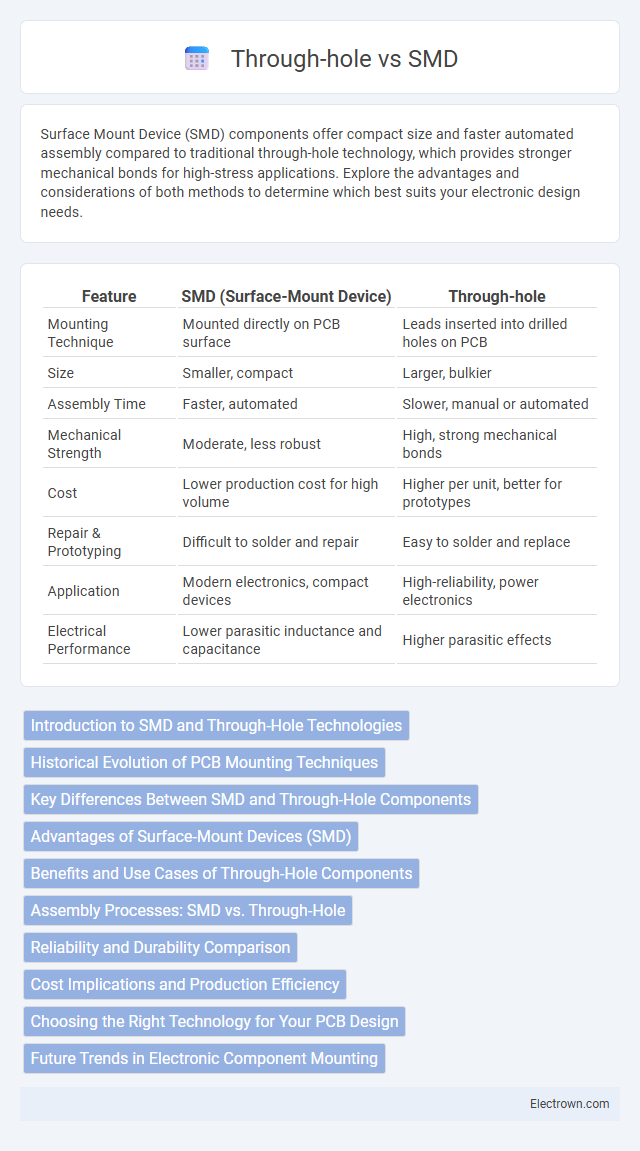Surface Mount Device (SMD) components offer compact size and faster automated assembly compared to traditional through-hole technology, which provides stronger mechanical bonds for high-stress applications. Explore the advantages and considerations of both methods to determine which best suits your electronic design needs.
Table of Comparison
| Feature | SMD (Surface-Mount Device) | Through-hole |
|---|---|---|
| Mounting Technique | Mounted directly on PCB surface | Leads inserted into drilled holes on PCB |
| Size | Smaller, compact | Larger, bulkier |
| Assembly Time | Faster, automated | Slower, manual or automated |
| Mechanical Strength | Moderate, less robust | High, strong mechanical bonds |
| Cost | Lower production cost for high volume | Higher per unit, better for prototypes |
| Repair & Prototyping | Difficult to solder and repair | Easy to solder and replace |
| Application | Modern electronics, compact devices | High-reliability, power electronics |
| Electrical Performance | Lower parasitic inductance and capacitance | Higher parasitic effects |
Introduction to SMD and Through-Hole Technologies
Surface-Mount Device (SMD) technology places components directly onto the surface of printed circuit boards (PCBs), offering higher component density and improved performance for modern electronics. Through-Hole technology involves inserting component leads through drilled holes in the PCB and soldering them on the opposite side, providing strong mechanical bonds ideal for heavy or high-stress applications. Understanding these fundamental differences helps you choose the best assembly method suited for your electronic design needs.
Historical Evolution of PCB Mounting Techniques
Surface Mount Device (SMD) technology emerged in the 1960s as a revolutionary alternative to the traditional Through-hole mounting technique, significantly enhancing PCB miniaturization and manufacturing efficiency. Through-hole technology dominated early electronics due to its robust mechanical connections and ease of prototyping, but the rise of SMD allowed for higher component density and automated assembly processes. The historical evolution from through-hole to SMD reflects advancements in electronic design, driven by demands for faster, smaller, and more reliable circuitry.
Key Differences Between SMD and Through-Hole Components
SMD (Surface-Mount Device) components are mounted directly onto the surface of a printed circuit board (PCB), allowing for smaller, lighter designs with higher component density compared to through-hole components, which have leads inserted into drilled holes on the PCB. Through-hole components provide stronger mechanical bonds and are preferred for applications requiring durability and high power handling, while SMD components excel in automated assembly and mass production efficiency. Understanding these key differences between SMD and through-hole components helps you choose the right technology for your electronic design needs depending on space constraints, mechanical strength, and production volume.
Advantages of Surface-Mount Devices (SMD)
Surface-Mount Devices (SMD) offer significant advantages including smaller size, higher component density, and improved performance at high frequencies compared to Through-hole technology. SMDs enable automated assembly processes that reduce manufacturing costs and enhance production speed. Your electronic designs benefit from increased reliability and improved signal integrity due to shorter lead lengths and reduced parasitics inherent in SMDs.
Benefits and Use Cases of Through-Hole Components
Through-hole components provide superior mechanical strength, making them ideal for applications subject to physical stress or high vibration, such as automotive and industrial equipment. Their larger size and ease of manual soldering benefit prototyping, repairs, and low-volume production where durability and reliability are critical. Choosing through-hole components enhances your project's robustness and ensures long-term stability in demanding environments.
Assembly Processes: SMD vs. Through-Hole
Surface-Mount Device (SMD) assembly involves placing components directly onto the PCB surface, enabling automated, high-speed production with precise component placement. Through-hole assembly requires inserting components' leads through drilled holes and soldering them on the opposite side, providing stronger mechanical bonds suitable for high-stress environments. Your choice between SMD and through-hole assembly affects manufacturing efficiency, reliability, and suitability for complex or rugged applications.
Reliability and Durability Comparison
Surface Mount Devices (SMD) generally offer higher reliability due to their smaller size and reduced lead lengths, which minimize inductance and enhance electrical performance under vibration and thermal cycling. Through-hole components provide superior mechanical strength and durability, making them ideal for applications subject to high mechanical stress or heavy-duty usage. The choice between SMD and through-hole depends on specific environmental demands and longevity requirements of the electronic assembly.
Cost Implications and Production Efficiency
Surface-mount devices (SMD) significantly reduce production costs due to their compatibility with automated assembly processes, minimizing labor expenses and enhancing throughput rates compared to through-hole technology. Through-hole components, while often preferred for mechanical strength and suitability in prototyping or low-volume production, involve higher labor costs and longer assembly times due to manual insertion and soldering. The efficiency of SMD manufacturing supports large-scale production with lower per-unit costs and faster turnaround, making it the preferred choice in cost-sensitive, high-volume electronics manufacturing.
Choosing the Right Technology for Your PCB Design
Surface-mount devices (SMD) offer higher component density and better performance for compact, high-frequency PCB designs, while through-hole technology provides superior mechanical strength and ease of prototyping. Selecting the right technology depends on factors such as board space, manufacturing volume, and application requirements; SMD suits automated mass production, whereas through-hole is preferred for robust connectors and components with mechanical stress. Balancing cost, reliability, and assembly complexity guides designers in optimizing PCB layouts for functionality and durability.
Future Trends in Electronic Component Mounting
Surface-Mount Device (SMD) technology dominates the future of electronic component mounting due to its smaller size, higher component density, and automated assembly advantages compared to Through-Hole technology. Innovations such as flexible PCBs, improved soldering techniques, and integration with IoT devices are accelerating the shift toward SMD, enabling your electronics to become more compact and efficient. While Through-Hole remains relevant for high-reliability and power applications, the trend clearly favors SMD for mass production and next-generation smart devices.
SMD vs Through-hole Infographic

 electrown.com
electrown.com